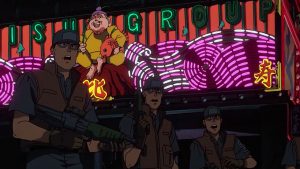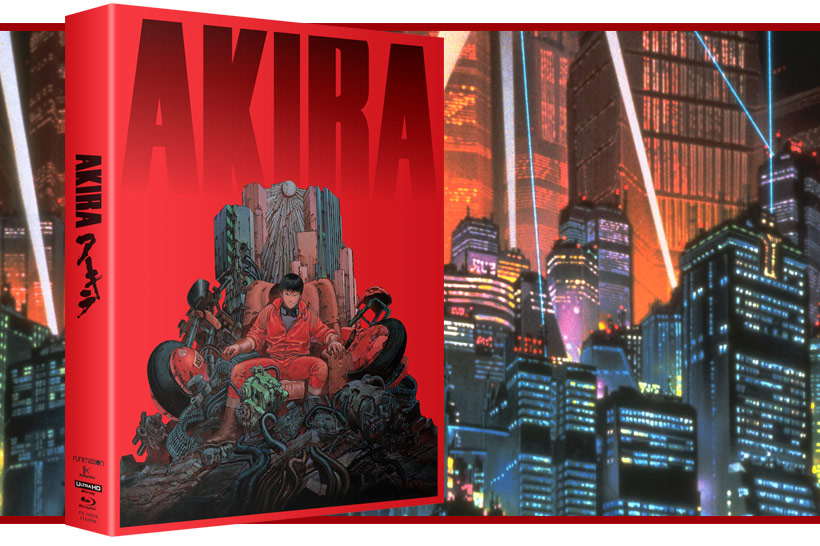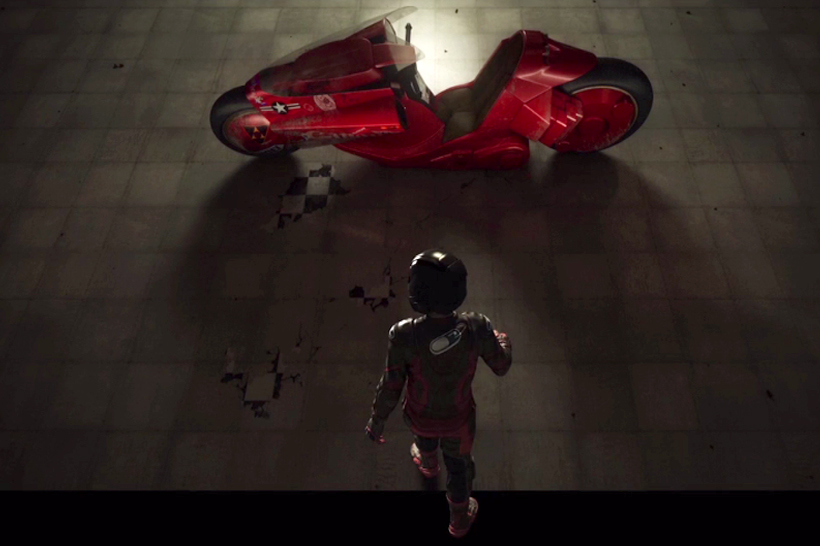Akira‘s reputation is perhaps best illustrated by the lack of synopsis on the back of this 4k Ultra HD/Blu-Ray Combo Standard Edition release. For many it doesn’t need one – the image of Kaneda in his red jacket standing before his iconic motorbike being featured on the cover works as effective shorthand to recall images of the post-war, cyberpunk, neon encrusted Neo-Tokyo, a city riddled with motorcycle gangs and the pervasive sense of a simultaneous fear and reverence of scientific progress.
But for those not in the know, Akira tells the story of Neo-Tokyo in the distant future of 2019 (well, distant when the film was first released in 1988), a volatile city that is no stranger to destruction and is on the brink of extreme change. Violence pervades the city, which is filled with motorcycle gangs, youth delinquents, rebels, protestors, and corrupt politicians. While in the midst of a turf war with a rival motorcycle gang, Capsule leader Kaneda is entangled in a government conspiracy when one of his gang members Tetsuo crashes straight into a secret government experiment – an escaped child with telekinetic abilities. With Kaneda and the rest of his gang arrested and Tetsuo abducted by the government, Kaneda becomes entangled in Neo-Tokyo’s resistance movement as he tries to figure out what has become of Tetsuo. All the while, Tetsuo struggles to contain the powers awakening within him and is drawn to whispers of a mysterious and powerful being called Akira.

The standard edition of Akira provides remastered 4K visuals and remixed audio for the iconic film adaptation of Katsuhiro Otomo’s manga series of the same name. The film is – pardon the expression – truly iconic. It cannot be overstated the impact the release of Akira had on the cyberpunk and sci-fi genre and animation in general, both within Japan and in the West (just look up video compilations the Akira motorcycle slide for an indication of how just a few seconds of the film has pervaded our media landscape). For additional context, explanation of technical artistry and history on the influence of Akira, check out the review of the film’s Special Edition release – it does bear repeating, but I won’t do so when it has already been well articulated.
Akira is unquestionably an expression of a very specific moment in time and oozes so much style that the ambience is intoxicating. Neo-Tokyo is grimy and filthy, its alleys covered in trash and some of its shop windows boarded up while immaculate restaurants operate a few blocks away and green trees grow above the ground in the skywalks connecting the city’s skyscrapers. The city feels unapologetically lived in, with gangs milling around the streets, fiery anti-government protests, and graffiti and cracks littering every facade. While this ambience makes the film incredibly visually engaging, it also does a lot of heavy lifting for Akira‘s narrative by imbuing a sense of substance and realism into the film’s subject matter. Akira encapsulates the feeling of being a person inhabiting a world falling apart at the seams and does so by capturing a number of 1980s Japanese sentiments and anxieties.
The increase in youth violence and delinquency is reflected through the film’s major characters Kaneda and Tetsuo. The two feel like fairly basic characters on the surface but in the context of anxieties surrounding broken societies creating “hollow” and apathetic youths carry a lot of thematic substance. Akira offers an interesting reflection on the way youths dissociate from engaging in “proper” society, choosing to disavow a world created for them through the actions of others and searching for power and status in the ways available to them – perhaps through joining gangs, being part of a resistance movement, or in the context of Akira, pursuing the telekinetic powers awakening within oneself. That being said, the characters are more than themes – Kaneda in particular is an incredibly expressive character, whose attitude, naivety, and crassness is extremely endearing and an often welcome feature amidst the film’s more dystopic elements.
Also present is the existence of a dichotomous relationship with science – the desire to push human capabilities to the limit in terms of studying telekinetic abilities paired with the wariness of the dangers of scientific progress, knowing all too well that such things can be weaponised. The allegory to the atomic bombs dropped on the Japanese cities of Hiroshima and Nagasaki is made extremely clear in the opening of the film, which depicts a dome of light exploding within Tokyo and destroying the city at the start of World War III.
This style and substance that permeates the film makes it a fascinating and (as previously stated) iconic entry to the cyberpunk and sci-fi genre. Although Tokyo has been rebuilt as “Neo-Tokyo” there is a sense that something is fundamentally wrong with the city, like a broken arm that hasn’t set right. The result is a petri dish of social unrest that drives the narrative and its characters forward, and a frankly delicious ambience that is worth the price of admission alone.

Akira is the product of an amazing amount of effort from the people who worked on it, resulting in a film that pushes the capabilities of animation. From the lip-syncing of pre-recorded dialogue, the gorgeous hand-painted backgrounds, and the stunning attention to detail in every frame (alley ways piled with garbage, lights from vehicle taillights creating streaming arcs of light, laboratory equipment chock full of wires, buttons, and paraphernalia), the film is a visual masterpiece. It depicts a sincere visceral-ness in scenes of violence, psychosis, and body horror of the dystopian variety, as well as intense technical detail in the depiction of its machines and technology. The lighting of the film, with neon bursting out of every surface, bold colours accompanied by pitch blacks, and ever-changing colour palettes to suit the time of day, create an incredible vibrancy. And like many of my favourite 1980s and 1990s anime, the lighting in the film has this distinct quality where it seems like the neon and lasers are so vibrant that they are burning through the film itself.
The soundtrack of course deserves equal praise to the animation. Akira‘s soundtrack is a combination of futuristic rhythm but with a focus on traditional wood and vocal sounds, giving it a distinct cultural identity. This release of Akira contains several special features that look at how the soundtrack was developed and it is genuinely fascinating (in addition to a storyboard collection and a segment on how the film was digitally restored). The soundtrack and the visuals work in tandem to create something that is purely and wholly Akira, creating a multitude of memorable moments throughout the film. In the first five minutes of the film alone, Akira establishes the overall tone of the film, several of its characters and the very pulse of Neo-Tokyo through excellent visuals and perfect utilisation of one of the film’s main themes. Frankly speaking, Akira‘s visuals and sound slap, and it is a worthy candidate for the visual remastering and remixed audio treatment.

I cannot think of a film more deserving of the remaster treatment than Akira – do not miss out on this iconic, visceral, and visually delightful pillar of the cyberpunk genre. There is no better time to experience this anime classic (except perhaps in a large theatre with surround sound), and the special features give a fascinating insight into the creation of one of the most ambitious anime projects to grace the screen. If you haven’t seen Akira already, there’s no time like the present – and if you have, it’s definitely worth a rewatch.
©1988 MASH・ROOM/AKIRA COMMITTEE. All Rights Reserved.
A review copy was provided by Madman Entertainment to the author for the purpose of this review.





